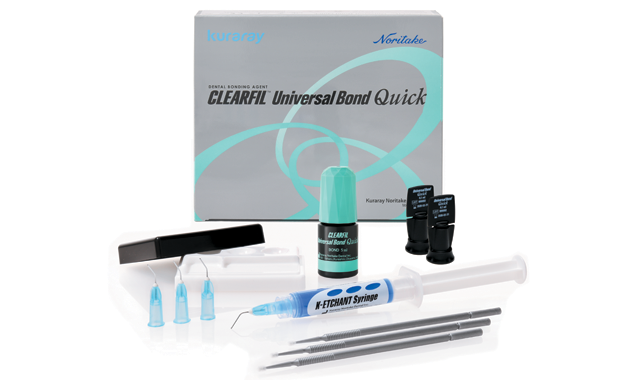The benefits of CLEARFIL Universal Bond Quick
Why one doctor uses this universal adhesive from Kuraray Noritake Dental.

Dr. Joe Willardsen graduated from Loma Linda University in California in 2000, and he has since gone on to train extensively in cosmetic dentistry. Recently, he opened his own dental lab, getting a firsthand view of what it’s like from the other side of the dental industry and everything that goes into creating indirect restorations. He also appreciates gaining insight into how to marry inorganic materials with the organic tooth structure.

“When a dentist cements a crown on a tooth and that crown is bonded correctly, there will be a good bond from tooth structure to the bonding resin and then from the resin to the porcelain itself,” he says. “Treating the porcelain is very important, all the way down to how you etch it, what you’re using to etch it, how you place the silane and what materials are in that silane.”
Dr. Willardsen says that Kuraray’s patent of MDP in 1981 was the beginning of modern bonding. “Through the years, bonding has gotten better and better, but MDP is the pinnacle of that,” he says.
While other companies began incorporating MDP into their products as Kuraray’s patents expired, more options became available on the market; however, MDP is difficult to produce, and many dentists, along with Dr. Willardsen, believe that Kuraray produces the purest form.
More from the author: The state of dental implants
“Because Kuraray had the first patent on MDP, the purity of their MDP is making a big difference,” he explains. “As other companies have started incorporating MDP into their bonding materials, they’re getting some of the success that MDP has to offer, but because they don’t have the purity there, it’s a difficult process to do.”
Dr. Willardsen has tried many bonding agents in the past, but he says he’s sold on CLEARFIL Universal Bond Quick because it saves time without sacrificing quality.
“This one step of going in and applying the primer for 20 seconds on three or four teeth takes time,” he says. “And you run the risk of that area getting contaminated. But with the new CLEARFIL Universal Bond Quick, you literally can’t make a mistake. It doesn’t allow the dentist to cut corners in that very important step of creating a hybrid layer. As soon as you apply it, it starts working.”
What he means by that is the application time takes just three seconds, compared to other leading bonding agents’ application time of 15 to 20 seconds.
Dr. Willardsen knows that there are pros and cons to different etching methods, which is why he values the CLEARFIL universal bonding agent.
“I can use it with total-etch or self-etching products, and it does both of them so much better and stronger than anything we’ve found,” he says.
Aside from its strength and ease of use, Dr. Willardsen appreciates that it comes in a single bottle. When he’s in a hurry, there are no snags to keep him from starting work or impediments to keep him from moving forward through the steps.
“Even if I’m in a hurry, I’m not cutting corners,” he says. “I know it’s working for me regardless of how quickly I am operating.”
Up next: Providing a biomimetic restoration...
Providing a biomimetic restoration
Using CLEARFIL Universal Bond Quick ensures a biomimetic restoration from the first step. While it has been shown to have the lowest water absorption among similar materials, according to a recent study, it is still hydrophilic. The water-loving material makes it behave more like natural teeth and less like traditional, hydrophobic materials. Plus, the MDP monomer means it has the strength and stability of natural teeth.
“When you’re applying the bonding agent to the tooth, you have a layer that’s not 100-percent tooth nor is it 100-percent resin or bonding agent,” he says. “To me, that one layer is so important to bonding and the long-term success of my restoration. It has to have low water absorption, it has to be extremely strong and it has to mimic function like a natural tooth.”
Trending article: The top 5 ways cosmetic dentistry can benefit your practice
Dr. Willardsen knows that there are no cutting corners with this agent. From the first step, there is a strong cure and almost no water absorption.
“That, in effect, is what is going to help our restorations last long term,” he says. “When they absorb water, they start to deteriorate.”
That, he says, leads to the dreaded dental cycle: A young patient gets a cavity and has a filling put in, then the patient returns to have a restoration replaced in his or her 20s or 30s, but the filling has worsened, so the patient gets a crown. The crown turns into a root canal, which turns into an extraction. With CLEARFIL Universal Bond Quick, Dr. Willardsen believes the cycle will be minimized.
“Patients aren’t having to have work redone and redone, ending up with a larger restoration until, finally, there’s nothing left of their tooth,” he says.
“As dentists, we’re constantly looking for the product that reduces stress in workflows while delivering the highest quality that we can possibly get. It’s almost like hunting for a unicorn, but I feel like that’s what we’re getting with this product - the strongest adhesive in the shortest application time. It’s the best of both worlds.”